
Castilleja, commonly known as Indian paintbrush or prairie-fire, is a genus of about 200 species of annual and perennial herbaceous plants native to the west of the Americas from Alaska south to the Andes, northern Asia, and one species as far west as the Kola Peninsula in northwestern Russia. These plants are classified in the family Orobanchaceae. They are hemiparasitic on the roots of grasses and forbs. The generic name honors Spanish botanist Domingo Castillejo.

Maclura tinctoria, known as old fustic and dyer's mulberry, is a medium to large tree of the Neotropics, from Mexico to Argentina. It produces a yellow dye called fustic primarily known for coloring khaki fabric for U.S. military apparel during World War I. This dye contains the flavonoid morin. It is dioecious, so both male and female plants are needed to set seed.

Plant reproductive morphology is the study of the physical form and structure of those parts of plants directly or indirectly concerned with sexual reproduction.

Orobanchaceae, the broomrapes, is a family of mostly parasitic plants of the order Lamiales, with about 90 genera and more than 2000 species. Many of these genera were formerly included in the family Scrophulariaceae sensu lato. With its new circumscription, Orobanchaceae forms a distinct, monophyletic family. From a phylogenetic perspective, it is defined as the largest crown clade containing Orobanche major and relatives, but neither Paulownia tomentosa nor Phryma leptostachya nor Mazus japonicus.
Dioecy is a characteristic of a species, meaning that it has distinct male and female individual organisms. Dioecious reproduction is biparental reproduction. Dioecy is one method that excludes self-fertilization and promotes allogamy (outcrossing), and thus tends to reduce the expression of recessive deleterious mutations present in a population. Flowering plants have several other methods of excluding self-fertilization, called self-incompatibility.

Castilleja indivisa, commonly known as Texas Indian paintbrush or entireleaf Indian paintbrush, is a hemiparasitic annual wildflower native to Texas, Louisiana, and Oklahoma in the United States. There are historical records of the species formerly growing in Arkansas, and reports of naturalized populations in Florida and Alabama.

Nuytsia floribunda is a hemiparasitic tree found in Western Australia. The species is known locally as moodjar and, more recently, the Christmas tree or Western Australian Christmas tree, as the display of intensely bright flowers during the austral summer coincides with the Christmas season.
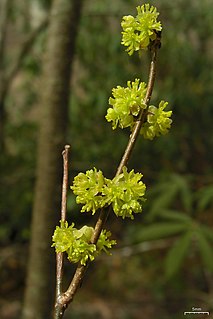
Lindera benzoin is a shrub in the laurel family, native to eastern North America, ranging from Maine and New York to Ontario in the north, and to Kansas, Texas, and northern Florida in the center and south. Within its native range it is a relatively common plant where it grows in the understory in moist, rich woods, especially those with exposed limestone.

Rumex acetosella, commonly known as red sorrel, sheep's sorrel, field sorrel and sour weed, is a species of flowering plant in the buckwheat family Polygonaceae. Native to Eurasia and the British Isles, the plant and its subspecies are common perennial weeds. It has green arrowhead-shaped leaves and red-tinted deeply ridged stems, and it sprouts from an aggressive and spreading rhizome. The flowers emerge from a tall, upright stem. Female flowers are maroon in color.
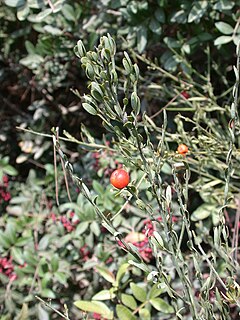
Osyris is a genus of plants in the family Santalaceae, one of the many genera known as sandalwoods, but not one of the true sandalwood. The species of this genus are mostly hemiparasitic, meaning although they can survive and grow by themselves, they also opportunistically tap into the root systems of nearby plants and parasitize them.
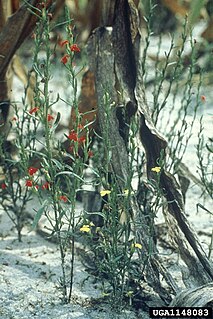
Striga asiatica, the Asiatic witchweed or the red witchweed, is a hemiparasitic plant in the family Orobanchaceae. It is native to Asia and sub-Saharan Africa, but has been introduced into other parts of the world including Australia and the United States. Asiatic witchweed is a serious agricultural pest, as it parasitises important crop species, including corn, rice, sorghum, and sugar cane, often causing substantial yield reductions.
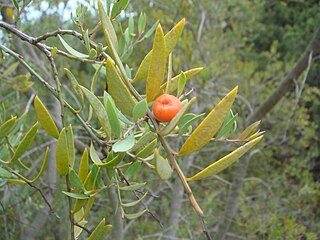
Osyris lanceolata, also known as African sandalwood, is used for its scented wood and to extract essential oil. The hemi-parasitic plant is found from South Africa to Zimbabwe and east Africa, including Tanzania, Kenya and Uganda; northwest Africa; the southern half of the Iberian Peninsula and Macaronesia. It grows in rocky areas or along the margins of dry forest, but is usually not abundant in any one place.

Adriana quadripartita, the bitter bush, is a shrub in the family Euphorbiaceae. The species, which is endemic to southern Australia, has an erect open habit, growing to between 0.5 and 3 metres or more high.
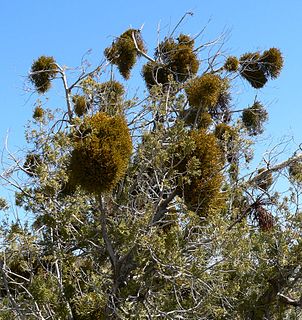
Phoradendron juniperinum is a species of flowering plant in the sandalwood family known by the common name juniper mistletoe. It is native to the southwestern United States and northern Mexico, where it grows in various types of woodland habitat. It has been reported from California, Nevada, Arizona, New Mexico, Oregon, Utah, Texas, Chihuahua and Sonora.
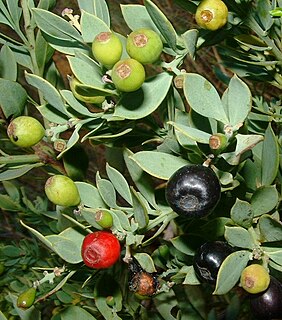
Osyris compressa is a facultatively hemiparasitic, mainly South African plant of the sandalwood family, Santalaceae. Until recently, the favoured binomial name was Colpoon compressum, but around 2001, the genus Colpoon was included in Osyris on the basis of comparative DNA studies. That assignment is not final, however, and according to the Kew Gardens plant list, Colpoon compressum P.J.Bergius, though still in review, is the accepted name.

Osyris alba, common name osyris, is a small perennial plant in the genus Osyris belonging to the Santalaceae family.

Harpephyllum is a genus of trees in the family Anacardiaceae. The sole species is Harpephyllum caffrum, a dioecious evergreen species from South Africa and Mozambique that is also cultivated. The fruit is edible.
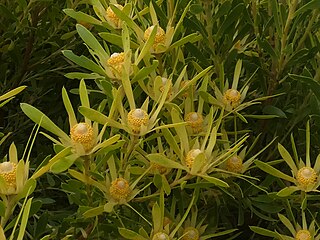
Leucadendron coniferum, also known at the dune conebush, is an evergreen, dioecious shrub or small tree of up to 4 m (13 ft) high, that has been assigned to the family Proteaceae. It has a whorl of conspicuous yellow leaves subtending the flowerheads. The flowers can be found in August and September. It grows in sandy soils near the coast of the Western Cape province of South Africa.
Phoradendron nickrentianum is a hemiparasitic plant in the Santalaceae family, native to Peru. There are no synonyms.

















